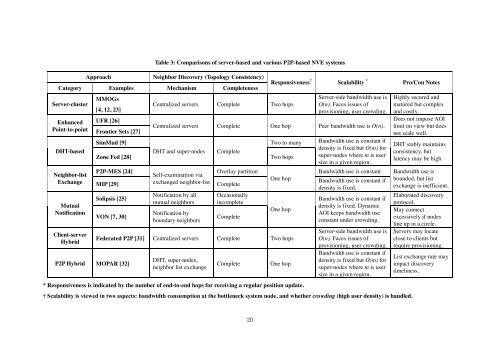A Scalable Peer-to-Peer Network for Virtual Environments - Evernote
A Scalable Peer-to-Peer Network for Virtual Environments - Evernote
A Scalable Peer-to-Peer Network for Virtual Environments - Evernote
Create successful ePaper yourself
Turn your PDF publications into a flip-book with our unique Google optimized e-Paper software.
Table 3: Comparisons of server-based and various P2P-based NVE systems<br />
Approach Neighbor Discovery (Topology Consistency)<br />
Category Examples Mechanism Completeness<br />
Server-cluster MMOGs<br />
[4, 12, 23]<br />
Enhanced UFR [26]<br />
Point-<strong>to</strong>-point Frontier Sets [27]<br />
DHT-based<br />
"*<br />
Responsiveness *<br />
Centralized servers Complete Two hops<br />
Scalability !<br />
Server-side bandwidth use is<br />
O(n). Faces issues of<br />
provisioning, user crowding.<br />
Centralized servers Complete One hop <strong>Peer</strong> bandwidth use is O(n).<br />
SimMud [9] Two <strong>to</strong> many<br />
Zone Fed [28]<br />
Neighbor-list<br />
Exchange MIP [29]<br />
Mutual<br />
Notification<br />
Client-server<br />
Hybrid<br />
DHT and super-nodes Complete<br />
Two hops<br />
Bandwidth use is constant if<br />
density is fixed but O(m) <strong>for</strong><br />
super-nodes where m is user<br />
size in a given region.<br />
P2P-MES [24] Overlay partition Bandwidth use is constant<br />
Solipsis [25]<br />
VON [7, 30]<br />
P2P Hybrid MOPAR [32]<br />
Self-examination via<br />
exchanged neighbor-list Complete<br />
Notification by all<br />
mutual neighbors<br />
Notification by<br />
boundary neighbors<br />
Occasionally<br />
incomplete<br />
Complete<br />
One hop Bandwidth use is constant if<br />
density is fixed.<br />
One hop<br />
Federated P2P [31] Centralized servers Complete Two hops<br />
DHT, super-nodes,<br />
neighbor list exchange<br />
Complete One hop<br />
* Responsiveness is indicated by the number of end-<strong>to</strong>-end hops <strong>for</strong> receiving a regular position update.<br />
Bandwidth use is constant if<br />
density is fixed. Dynamic<br />
AOI keeps bandwidth use<br />
constant under crowding.<br />
Server-side bandwidth use is<br />
O(n). Faces issues of<br />
provisioning, user crowding.<br />
Bandwidth use is constant if<br />
density is fixed but O(m) <strong>for</strong><br />
super-nodes where m is user<br />
size in a given region.<br />
!"#$%&%'(&()*"(+",(-.-/"(0").1"%+2-$)+3"'%0/.(/)4"$10+562)(10"%)")4-"bottleneck system node, and whether crowding (high user density) is handled.<br />
Pro/Con Notes<br />
Highly secured and<br />
matured but complex<br />
and costly.<br />
Does not impose AOI<br />
limit on view but does<br />
not scale well.<br />
DHT stably maintains<br />
consistency, but<br />
latency may be high<br />
Bandwidth use is<br />
bounded, but list<br />
exchange is inefficient.<br />
Elaborated discovery<br />
pro<strong>to</strong>col.<br />
May connect<br />
excessively if nodes<br />
line up in a circle.<br />
Servers may locate<br />
close <strong>to</strong> clients but<br />
require provisioning.<br />
List exchange rate may<br />
impact discovery<br />
timeliness.
















